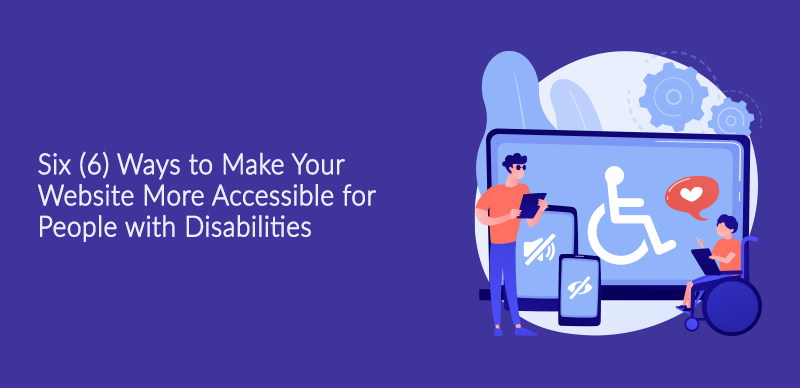Six (6) Ways to Make Your Website More Accessible for People with Disabilities

Making your website accessible for disabled people makes sense for any business. An accessible website benefits disable people by enabling them to understand content, navigate and locate information, and perform a variety of tasks more easily.
Every website owner wants to attract as many site visitors as possible. To help achieve this goal, it is important to make sure that everyone associated with your website has easy access to the information they are looking for. Fortunately, accessibility is not difficult to implement. We just need to understand the underlying issues that make it impossible or hard for certain people to use the site.
Here, in this blog post, we explain some simple ways to make your website accessible to everyone, especially people with disabilities.
Six (6) Ways to Make Your Website More Accessible for Disabled People
1. Add keyboard Navigation
For visually impaired or blind users, navigation is one of the big challenges. Since they cannot use the mouse to browse the website content, you must include keyboard navigation feature into your business website. Blind people use Braille keyboards to access your website.
In addition, you can make sure people with disabilities have access to all the interactive elements, including Anchor text, URLs, Forms, Drop-down menus, Dialog boxes, Widgets, CTAs, etc. You can also utilize HTML links, form fields and buttons to ensure all your website elements are keyword accessible.
2. Add Images with Alt Text
An image is worth a thousand words, and it may describe many emotions. But pictures are an accessibility barrier for visually impaired users. Assistive technologies such as refreshing braille readers and screen readers help them access the site. However, none of these technologies can read text in the pictures.
Therefore, you need to include Alt text to describe about your image to disabled users. Use attribute for brief descriptions and “Longdesc Tag" for lengthy descriptions.
3. Accessibility-friendly Content
Of course, it is important to create a website with an accessible design, but content should be a major concern when making easy access to your website. Creating your website content with highlights are crucial. When reading through screen reader, it makes content easier and better to understand. In addition, headings help screen readers better understand your content, allowing for easier navigation on every web page of your website. You also make sure that your content is accessible by writing out all uniquely naming links, acronyms, anchor texts and having descriptive names.
While all of these steps are necessary ensuring that everyone who accesses your website finds it valuable, remember that your content must be attractive to all your website users.
4. Use unique link text
Users who use a screen reader and who are blind rely on specific link text when navigating through a link. Simple link text - such as "Click here" or "Read more" does not describe the destination of the link.
Explanations may appear in nearby paragraphs, making it difficult for users with assistive technology to locate the link they are looking for. We need to ensure that all the links on the website are detailed and unique.
5. Use colors with care
We often talk about color blindness, which is a black and white problem. However, is it more spectrum because different people perceive colors in different ways? As such, you should choose the colors that are well contrasted to your website to ensure that everyone, especially disable people can distinguish between the different elements on the web page.
Also, please make sure the text stands out against the background. Ideally, you have to set the dark color against a light color, so that they do not blend into each other. It is also better to avoid clashing colors that could cause eye strain.
6. Provide accessible videos
If there is video content on your website, it is imperative to provide good audio descriptions and captions to make it accessible to the disabled users. Captions should relate to the visual video content and capture all meaningful sounds and spoken dialogues so that hard of hearing or deaf users can easily access your videos.
Likewise, please provide access to a secondary audio track that describes the visual content of your videos so that the visually impaired or blind can follow. We should also use an accessible media player that supports all these accessibility features.
Conclusion – Website Accessibility Matters
Making your website accessible to everyone, especially people with disabilities should be a top priority. Having accessible website helps improve customer base, boost brand image, increase your search engine rankings, and make general improvements in usability.
We hope this article has given you a useful high-level overview of accessibility and how to make your website accessible to people with disabilities. If you would like to make your website accessible to everyone, please feel free to contact us. Our accessibility experts are here to assist you at any stage of your website accessibility journey.
